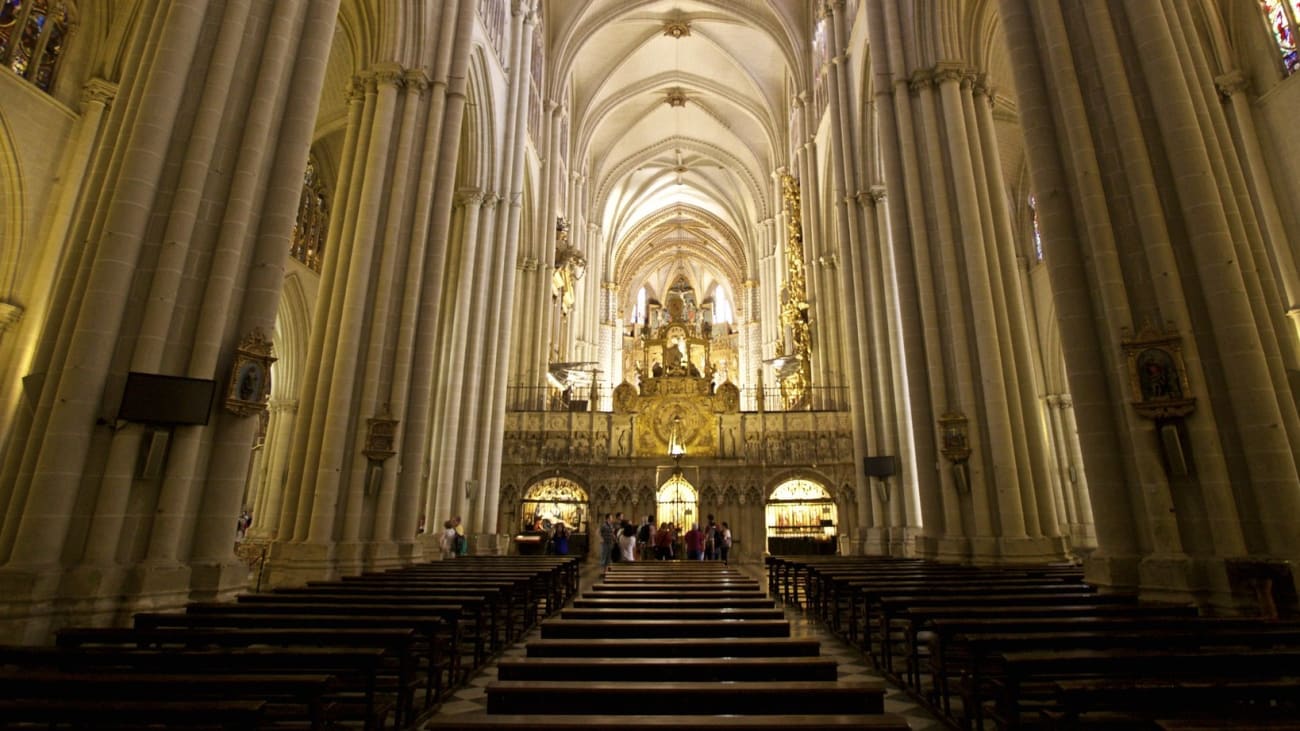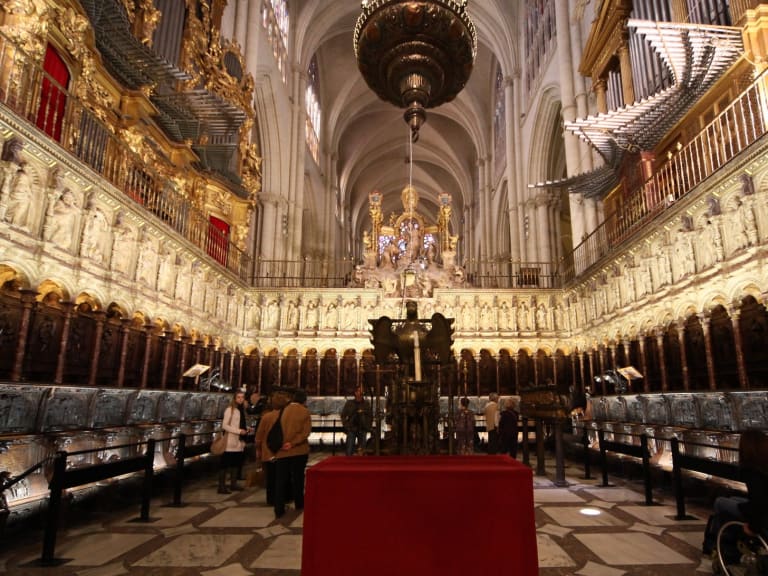Things You Can´t Miss at the Cathedral of Toledo
Toledo Cathedral is one of the most important cathedrals in Spain, due to its great historical and artistic wealth, discover everything there is inside.

Interior de la catedral |©Francisco Aragão
Toledo Cathedral is an architectural complex dating from the 13th century. It is the main tourist attraction in this city of Castilla la Mancha and one of the most prized cathedrals in Spain.
If you are planning a trip to the province of Toledo and do not know what to see and do in Toledo, do not hesitate to include the Catedral Primada in your travel itinerary. Read on to find out what this incredible place has to offer.
1. Chapter House

The first thing to visit in Toledo Cathedral is the Chapter House. This is divided into two parts: the hall itself and the anteroom. As for the antechamber, its construction dates from 1500 to 1512 and the architects who gave it life were Enrique Egas and Pedro Gumiel. It also has a beautiful façade designed by Copín de Holanda.
The interior of the antechamber is a mixture of Gothic and Mudejar styles. It is rectangular in shape and on the sides you will find a multitude of cupboards in which the chapter minutes are filed. The cupboards on the left wall of the anteroom date from 1549 and 1551. On the other hand, those on the right wall were made in 1780.
As for the chapterhouse itself, you will be struck by the gilded decoration by Diego López de Arenas and Francisco Lara. The oil paintings depicting different scenes from the Life of the Virgin Mary and the Passion of Christ also stand out.
Just below these paintings, you can see a set of 32 portraits of the first archbishops of Toledo, which were painted by Juan de Borgoña. In the centre of the back wall of the Chapter House is the Archbishop's Chair, the work of Copín de Holanda. If you don't want to miss the smallest detail, I recommend a guided tour of the Cathedral.
2. Mozarabic Chapel

Toledo Cathedral has a Moorish past, being located on the same site as the city's mosque. During those times, the liturgy of the Hispanic Mozarabic rite was celebrated. In an attempt to ensure that this was not buried, Cardinal Cisneros founded the Mozarabic chapel or Corpus Christi chapel in 1504.
Initially, the purpose of this site was to hear mass in the Mozarabic rite, something that is still done today. The architect to whom we owe the pleasure of being able to visit this place is Enrique Egas. However, in 1622 the chapel burnt down and had to be rebuilt by Jorge Manuel, son of the famous Renaissance painter El Greco. The chapel was completed in 1631.
As soon as you enter the interior, you will see a 17th-century dome, which presided over what was once the old chapterhouse, of which today only a starry sky remains. Here you can see a beautiful mosaic of the Virgin and Child as well as an engraving by Carlo Maratta that was rescued from the bottom of the sea after a shipwreck.
If you want to see this and the other parts of this Christian monument, I recommend that you take a look at the opening hours of Toledo Cathedral.
3. The Transcourse

In the central nave of Toledo Cathedral there is a huge and eye-catching choir. Just behind it is the choir loft, which was built during the pontificate of Archbishop Pedro Tenorio and dates from the end of the 14th century. It features several columns, which are thought to have formed part of the city's ancient mosque.
The sculptures in the choir loft all refer to the Holy Scriptures, so that illiterate people could understand their meaning. The first one from the left refers to the Creation, accompanied by the expulsion of Adam and Eve from Paradise. There are also sculptures referring to scenes from the Flood, as well as figures honouring Innocence and Guilt.
In the same place where there used to be a door in the centre of the transept, today you can see a chapel in honour of the Virgin of the Star, which has a Gothic-style statue carved in stone. If you look to the right, you will see the chapel of Santa Catalina, also dedicated to Santa Inés and Santa Águeda, which dates from 1516.
On the left, on the other hand, you will find the altar of the Tended Christ. The work shows the dead Christ in the arms of the Virgin, together with the Three Marys, Saint John, Nicodemus and Joseph of Arimathea. If you want to get to know this and the other relics of the Cathedral, I recommend a guided tour of Toledo Cathedral and its 5 treasures.
4. The Chapel of the Descent

Of the 24 chapels found in Toledo Cathedral, the first of them is the Chapel of the Descent. Although it is not certain, it is believed that this is the place where the main altar of the church of Santa María was located.
This chapel is very important because of the legend that says that in the year 666, the Virgin descended from heaven to reward Archbishop Ildefonso for his defence against the heretical doctrines of Ervigio.
On the site you will find a gate that secures the tomb of Cardinal Moscoso, who died in 1655. You can also see an altarpiece by the sculptors Covarrubias, Borgoña and Almonacid. Next to it, you can see a stone guarded by a grille. According to legend, this is the stone on which the Virgin rested her feet at the moment of the Descent.
The visit to the Chapel of the Descent is included in the price of the tickets to Toledo Cathedral.
5. The Treasure

Under what used to be the Chapel of San Juan, you will find the Treasure Room. You can enter it through a façade by Covarrubias, which dates from 1537.
Two clay statues adorn this door. Both, dating from 1523, were created by Olarte and represent Christ with the cross and Saint Peter kneeling beside him. The room is dominated by a plaster ceiling that originally formed part of the Chapel of the New Kings.
The treasure room contains the cathedral's most important works of gold and silverware. Just above the display cases in which they are housed, you can see the paintings for the tapestry cartouches. However, the great protagonist is the Processional Monstrance, which is said to have been made with the first gold to arrive from the New World.
It was a legacy from Queen Isabella the Catholic to Cardinal Cisneros. The monstrance is 2.5 metres high and consists of three sections. It is made up of 5600 pieces and 250 statuettes made of enamel and gilded silver. A diamond cross dating from 1600 presides over it. In addition to the monstrance and the other works of art in this room, one of the most important is the Saint Louis Bible, a gift from the French royal workshop to Alfonso X.
6. The cloister

If you leave the naves through the Puerta de la Presentación, you will come to the cloister, which has wooden doors that date back to 1601. The first stone was laid in this hall on 14 August 1389, and the work was completed in 1399. The cloister of Toledo Cathedral is made up of four galleries, each measuring more than 50 metres.
The doorway leading to the cloister is known as the Puerta del Mollete or Puerta del Niño Perdido. Its walls were once adorned with paintings by Pedro Berruguete, but today you can see frescoes by Mariano Salvador Maella and Francisco Bayeu, which were painted under the archbishopric of Lorenzana.
Of all of them, one of the most striking is that of the Santo Niño de la Guardia. The painting refers to a very old legend of Toledo tradition, according to which the Hebrews decide to teach the Christians a lesson by kidnapping a child in the town of La Guardia.
If you continue walking, you will also see a pedestal and a stone commemorating the consecration of the temple. The cathedral also has a high cloister, which was to be the residence of the Chapter. However, it ended up being the home of the cathedral's workers and even housed Isabella I and Philip II.
7. Chapel of San Blas

Next to the cloister is the Chapel of San Blas, which was built to be the burial place of Archbishop Tenorio. The work was completed on 10 May 1399, just 10 days before the archbishop's death. You can enter the chapel of San Blas through a Gothic door decorated with images of the Assumption.
Inside, you will be able to contemplate a multitude of fresco paintings depicting different passages from the life of Christ. However, due to the location of the chapel, the humidity has affected its conservation. Right in the centre of the chapel is the white marble tomb of Archbishop Tenorio, which rests next to the tomb of the Bishop of Palencia.
8. Parish chapel of San Pedro

I continue this tour of Toledo Cathedral with the parish chapel of San Pedro. In order to access it, you will have to return from the chapel of San Blas to the naves of the cathedral through the Puerta de Santa Catalina. This chapel serves as a parish church and was founded in 1422 by Archbishop Sancho de Rojas. Inside you can see three altars decorated with paintings by Bayeu, dating from the 18th century, and the archbishop's tomb.
Just in front of the chapel, at one time, there was a stone in the shape of a cradle where children who had been conceived out of wedlock or who had been born into families that could not take care of them were abandoned.
Its name is the stone for foundlings and all those who were placed in it were in the care of the cathedral. There came a time when this matter became untenable for the temple, so Cardinal Mendoza founded the Hospital de Santa Cruz, in order to be able to take in these children.
9. The sepulchres on the floor of Toledo Cathedral

As you will have seen throughout this article, there are many chapels in Toledo Cathedral that have been built as tombs for important members of the Archbishopric. Obviously, not everyone could have access to such wealthy sepulchres, as they involved the costs of building the chapel and the dowry for the chaplains who were in charge of the masses.
After some time, the cathedral was affected by the high number of sepulchres, as well as by the liturgical acts they entailed. Thus, masses were forbidden to be celebrated on Sundays and public holidays. For all those who did not have the economic resources that a chapel implied, it was ordered that the sepulchres had to be at the same level as the pavement.
Walking around the cathedral, you can see the different tombs in the ground you walk on, as well as the inscriptions detailing the dates of birth and death and the names of the people found there.
10. The Clock Gate

The Puerta del Reloj, also known as the Puerta de las Ollas or the Puerta de la Chapinería, is a 15th-century work by master builder Paulo. On its exterior you can see four large canvases that refer to Saint Thomas Aquinas and different moments in the foundation of the cathedral.
Above the door is a clock from the end of the 18th century, which is what gives the door its name. Although you cannot see it, its mechanism contains an angel with a scythe that alludes to death.
At the top, next to the door, you will find a horn on which hangs a chain. Although it is not known, certain legends say that it belongs to one of the oxen on which the first stones of the cathedral were transported.
11. The Main Chapel

This part of the cathedral can be somewhat overwhelming to the eye, as it is loaded with riches. On the site where it stands today, there used to be the chapel of the Old Kings. One of the most important treasures of the Main Chapel of Toledo Cathedral is the Renaissance grille from 1548 made by Francisco de Villalpando.
At either end of the grille are two statues, one of the Virgin and the other of Saint Gabriel. Right in the centre of the grille, you can see a coat of arms with the imperial coat of arms of Charles I. The grille is crowned with a figure of Christ.
The chapel, which was previously the burial chapel ordered to be built by King Sancho IV, dates from the 16th century. Thus, before it was built, Cardinal Cisneros asked the Catholic Monarchs to transfer the monarchs to another of the cathedral's chapels.
One of the most important parts of the main chapel is the polychrome wooden altarpiece, which was made by Petit Jean, under the guidelines of Enrique Egas and Pedro de Gumiel. Its construction lasted from 1498 to 1504. This altarpiece has three sections. Right in its centre is the tabernacle, which is the place where the consecrated bread is kept for the moment of the Eucharist.
12. The choir

Just at the opposite end of the Main Chapel, there is a large grille that protects the choir area. It was built in 1548 by Domingo Céspedes. The grille has two access doors and is made of iron, gold and silver.
The choir is one of the most special places in this temple and is only used for praying the canonical hours. It is located in the heart of the cathedral and has a choir loft and a choir loft. The lower choir was built in 1495 by Rodrigo Alemán and has 54 seats on which various scenes from the conquest of Granada by the Catholic Monarchs are depicted.
Both Alonso de Berruguete and Philip of Burgundy participated in the upper part. This makes it possible to distinguish between two styles in the upper part. The work is made of walnut wood and you can see representations of different figures from the Church. On the other hand, above the Archbishop's chair, you can see a sculpture that refers to the Transfiguration of the Lord. Finally, in the centre you can also see a sculpture of the White Virgin.
